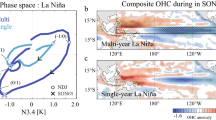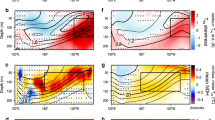Abstract
The El Niño/Southern Oscillation (ENSO) phenomenon is the strongest natural interannual climate fluctuation1. ENSO originates in the tropical Pacific Ocean and has large effects on the ecology of the region, but it also influences the entire global climate system and affects the societies and economies of manycountries2. ENSO can be understood as an irregular low-frequency oscillation between a warm (El Niño) and a cold (La Niña) state. The strong El Niños of 1982/1983 and 1997/1998, along with the more frequent occurrences of El Niños during the past few decades, raise the question of whether human-induced ‘greenhouse’ warming affects, or will affect, ENSO3. Several global climate models have been applied to transient greenhouse-gas-induced warming simulations to address this question4,6, but the results have been debated owing to the inability of the models to fully simulate ENSO (because of their coarse equatorial resolution)7. Here we present results from a global climate model with sufficient resolution in the tropics to adequately represent the narrow equatorial upwelling and low-frequency waves. When the model is forced by a realistic future scenario of increasing greenhouse-gas concentrations, more frequent El-Niño-like conditions and stronger cold events in the tropical Pacific Ocean result.
This is a preview of subscription content, access via your institution
Access options
Subscribe to this journal
Receive 51 print issues and online access
$199.00 per year
only $3.90 per issue
Buy this article
- Purchase on Springer Link
- Instant access to full article PDF
Prices may be subject to local taxes which are calculated during checkout




Similar content being viewed by others
References
Philander, S. G. H. El Niño, La Niña, and the Southern Oscillation (Academic, San Diego, 1990).
Glantz, M. H., Katz, R. W. & Nicholls, N. Teleconnections Linking Worldwide Climate Anomalies (Cambridge Univ. Press, 1991).
Trenberth, K. & Hoar, T. The 1990–1995 El Niño–Southern Oscillation event: Longest on record. Geophys. Res. Lett. 23, 57–60 (1996).
Knutson, T. R., Manabe, S. & Gu, D. Simulated ENSO in a global coupled ocean–atmosphere model: multidecadal amplitude modulation and CO2sensitivity. J. Clim. 10, 138–161 (1997).
Tett, S. Simulation of El Niño-Southern Oscillation-like variability in a global AOGCM and its response to CO2increase. J. Clim. 8, 1473–1502 (1995).
Meehl, G. A., Brantstator, G. W. & Washington, W. M. Tropical Pacific interannual variability and CO2climate change. J. Clim. 6, 42–63 (1993).
Cane, M. A. et al. Twentieth-century sea surface temperature trends. Science 275, 957–960 (1997).
Roeckner, E., Oberhuber, J. M., Bacher, A., Christoph, M. & Kirchner, I. ENSO variability and atmospheric response in a global atmosphere-ocean GCM. Clim. Dynam. 12, 737–754 (1996).
Bacher, A., Oberhuber, J. M. & Roeckner, E. ENSO dynamics and seasonal cycle in the tropical Pacific as simulated by the ECHAM4/OPYC3 coupled general circulation model. Clim. Dynam. 14, 431–450 (1997).
Oberhuber, J. M., Roeckner, E., Christoph, M., Esch, M. & Latif, M. Predicting the '97 El Niño event with a global climate model. Geophys. Res. Lett. 25, 2273–2276 (1998).
Houghton, J. T., Callander, B. A. & Varney, S. K. V. (eds) IPCC Climate Change 1992. The Supplementary Report to the IPCC Scientific Assessment (Cambridge Univ. Press, 1992).
Meehl, G. A. & Washington, W. M. El Niño-like climate change in a model with increased atmospheric CO2concentrations. Nature 382, 56–60 (1996).
Ramanathan, V. & Collins, W. Thermodynamic regulation of ocean warming by cirrus clouds deduced from observations of the 1987 El Niño. Nature 351, 27–32 (1991).
Roeckner, E., Bengtsson, L., Feichter, J., Lelieveld, J. & Rodhe, H. Transient climate change simulations with a coupled atmosphere-ocean GCM including the sulfur cycle. J. Clim.(in the press).
Battisti, D. S. & Hirst, A. C. Interannual variability in the tropical atmosphere/ocean system: Influence of the basic state, ocean geometry and non-linearity. J. Atmos. Sci. 46, 1687–1712 (1989).
Münnich, M., Cane, M. A. & Zebia, S. E. Astudy of self-excited oscillations of the tropical ocean–atmosphere system, Part II: Nonlinear cases. J. Atmos. Sci. 48, 1238–1248 (1991).
Tziperman, E., Stone, L., Cane, M. A. & Jarosh, H. El Niño chaos: overlapping of resonances between the seasonal cycle and the Pacific Ocean–Atmosphere Oscillator. Science 264, 72–74 (1994).
Stone, L., Saparin, P. I., Huppert, A. & Price, C. El Niño chaos: The potential role of noise and stochastic resonance on the ENSO cycle. Geophys. Res. Lett. 25, 175–178 (1998).
Acknowledgements
We thank T. P. Barnett for discussion and M. Münnich for help with data processing. This work was sponsored by the German government under its programme ‘Klimavariabilität und Signalanalyse’ and by the European Union through its ‘SINTEX’ programme. The climate model integrations were performed at the Deutsches Klimarechenzentrum.
Author information
Authors and Affiliations
Corresponding author
Rights and permissions
About this article
Cite this article
Timmermann, A., Oberhuber, J., Bacher, A. et al. Increased El Niño frequency in a climate model forced by future greenhouse warming. Nature 398, 694–697 (1999). https://doi.org/10.1038/19505
Received:
Accepted:
Issue Date:
DOI: https://doi.org/10.1038/19505
This article is cited by
-
Assessing the future influence of the North Pacific trade wind precursors on ENSO in the CMIP6 HighResMIP multimodel ensemble
Climate Dynamics (2024)
-
A pilot study to estimate the population size of endangered Galápagos marine iguanas using drones
Frontiers in Zoology (2023)
-
A Review of El Niño Southern Oscillation Linkage to Strong Volcanic Eruptions and Post-Volcanic Winter Warming
Earth Systems and Environment (2023)
-
ENSO atmospheric feedbacks under global warming and their relation to mean-state changes
Climate Dynamics (2023)
-
Unexpected limitation of tropical cyclone genesis by subsurface tropical central-north Pacific during El Niño
Nature Communications (2022)
Comments
By submitting a comment you agree to abide by our Terms and Community Guidelines. If you find something abusive or that does not comply with our terms or guidelines please flag it as inappropriate.



